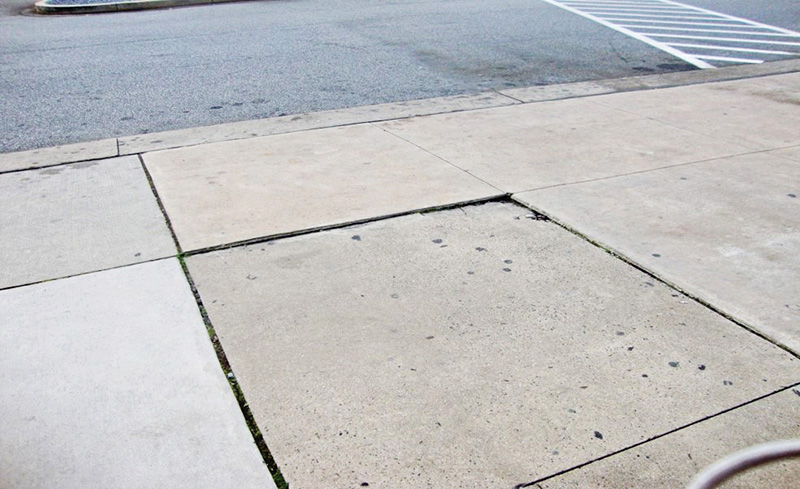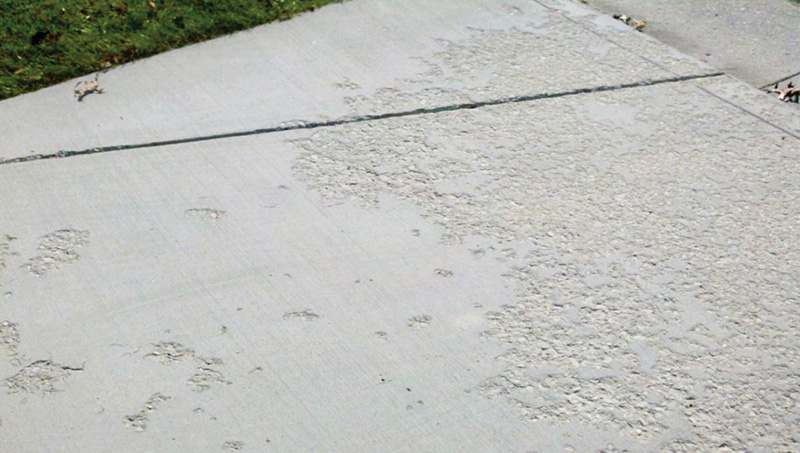Restore — don’t replace — that broken concrete.
By Vince Riccardo
There are essentially two guarantees with concrete: it’s going to harden, and it’s going to crack.
Knowing when and how to intervene when it does crack, however, takes an experienced eye. While concrete is the most commonly used material in construction, it can also be among the most misunderstood — particularly as it relates to maintaining and repairing it.
If it’s inevitably going to crack, at what point should something be done? And what should that next step be?
Identifying when a crack is in need of intervention
Safety for customers and employees is among the primary drivers determining when a crack should be addressed. The Americans with Disabilities Act considers it a trip hazard if there’s a change in grade of greater than a quarter-inch, so it doesn’t take much to become dangerous.
 “The main reason for us to fix cracks is to avoid safety issues with our guests,” says Don Pepper, senior facilities manager, Bob Evans Farms. “They could become a trip hazard, which could then become a lawsuit. Between the safety factor and the aesthetics, too, it behooves us to fix damaged concrete right away.”
“The main reason for us to fix cracks is to avoid safety issues with our guests,” says Don Pepper, senior facilities manager, Bob Evans Farms. “They could become a trip hazard, which could then become a lawsuit. Between the safety factor and the aesthetics, too, it behooves us to fix damaged concrete right away.”
For many retailers, customer service begins the moment a customer pulls into the parking lot, so they strive to maintain an attractive, well-conditioned building exterior. Deep cracks in the sidewalk can leave a negative perception in people’s minds, so maintaining the sidewalks, curbs, entryways and handicap ramps is critically important.
Untreated cracks can also lead to a worsening of the damage. Avoid a higher cost and more significant disruption later by fixing your broken concrete sooner. Water penetrates improperly sealed cracks and, over time, makes them worse or leads to even more cracks.
What concrete damage is a candidate for restoring?
In almost all cases, broken or cracked concrete can be “restored” as opposed to tearing it up and replacing it. Restoring essentially involves maintaining the already settled and still viable sub-base, and applying an engineered epoxy concrete alternative as the new top layer.
The bias in the industry is to jump too quickly to replacing concrete before exploring other alternatives, yet nine out of 10 times it is likely a candidate for restoration.
“For us, we thought rather than replace all the sidewalks let’s resurface them,” Pepper says. His company has been resurfacing with a concrete-alternative epoxy for 3 years at multiple locations. “The epoxy material holds up well, it’s faster and a lot easier to apply, and it doesn’t disrupt the flow of traffic as far as our guests are concerned. Further, it’s a lot less expensive to do a restoration than replace.”
Let’s run through a scenario. You find a major crack in your concrete; what is the best way to handle it? For starters, don’t jump too quickly into thinking you need to replace it. There’s a case to be made for a less disruptive solution.
The absolute “have to replace” is if the sub-base is unstable and the slab shows signs of obvious movement. At that point the concrete has lost its integrity and must be completely replaced. Another must-replace example is a weight-related crack that results in a shattered-mirror effect on the concrete. Typically this is caused by a vehicle or heavy equipment brought in on a pad that wasn’t designed to hold it.
 If your concrete is pitted and worn but still structurally sound, you might be able to avoid the time and disruption inherent in replacing your concrete by repairing and resurfacing it instead. Age may actually work in your favor because older concrete, which is often the best concrete, has settled and already passed the “good concrete mix” test of time.
If your concrete is pitted and worn but still structurally sound, you might be able to avoid the time and disruption inherent in replacing your concrete by repairing and resurfacing it instead. Age may actually work in your favor because older concrete, which is often the best concrete, has settled and already passed the “good concrete mix” test of time.
If you’re unsure if your concrete slab is structurally sound, it is wise to have an experienced contractor take a look before determining if you should resurface or replace.
Why restore versus replace?
On a pad of concrete built for vehicle traffic, you’ll face a minimum of a 10-day shutdown for a replacement job; and a 3-day minimum for foot-traffic areas. Further, you’ll have jackhammers, dump trucks and backhoes on-site, and landscaping to tear out and replace. Plus the sub-base will need to be recreated after the concrete is out. How unwelcome is that kind of disruption to a retail customer?
Concrete sidewalks, driveways and floors can be worn and pitted but still be considered structurally sound. Also take into account an aged concrete slab has very little risk of further settlement or movement.
Instead, consider installing a sealed, epoxy-resin overlay to the surface of your concrete. Epoxy-based systems can be three to four times stronger than conventional concrete, are able to seal the surface to prevent water and other substances from penetrating, and can considerably extend the life of your concrete slab.
Restoring broken concrete costs less than replacing
Resurfacing with an epoxy overlay concrete typically costs less than replacement, all factors considered, and it can even come with a warranty.
Installing an epoxy overlay is a specialty service. In effect, it’s an engineered concrete, and needs to be installed by an experienced contractor. When resurfacing with epoxies, look for a concrete resurfacing contractor for best results; one with a documented track record and recent references; and one that is extremely familiar with the materials being used.
— Vince Riccardo is director of operations, Simon Surfaces, a national concrete repair/restoration and floor resurfacing manufacturer and contractor. Riccardo has more than 30 years of experience installing concrete and concrete repair and resurfacing systems. Email the author at [email protected].
